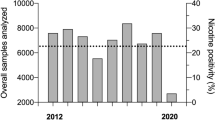Abstract
A high incidence of positive cases for cannabinoids, in analyses for doping control in sports, has been observed since the International Olympic Committee (IOC) included them in the 1989 list of prohibited drugs under the title of classes of prohibited substances in certain circumstances. Where the rules of sports federations so provide, tests are conducted for marijuana, hashish or any other cannabis product exposure by means of urinalysis of 11-nor-delta-9-tetrahydro-cannabinol-9-carboxylic acid (carboxy-THC) the main metabolite of delta-9-tetrahydrocannabinol (THC). Concentrations >15 ng/mL (cut-off value) in confirmatory analytical procedures are considered doping. Cannabis is an illicit drug in several countries and has received much attention in the media for its potential therapeutic uses and the efforts to legalise its use.
Studies have demonstrated that the use of cannabinoids can reduce anxiety, but it does not have ergogenic potential in sports activities. An increase in heart rate and blood pressure, decline of cardiac output and reduced psychomotor activity are some of the pharmacological effects of THC that will determine a decrease in athletic performance. An ergolytic activity of cannabis products has been observed in athletes of several different sport categories. In Brazil, analyses for doping control in sports, performed in our laboratories, have detected positive cases for carboxy-THC in urine samples of soccer, volleyball, cycling and other athletes.
It is our intention to discuss in this article some points that may discourage individuals from using cannabis products during sports activities, even in the so-called permitted circumstances defined by the IOC and some sports federations.

Similar content being viewed by others
Notes
The use of tradenames is for product identification purposes only and does not imply endorsement.
References
Verroken M. Drug use and abuse in sport. J Clin Endocrinol 2001; 14(1): 1–23
Mottram DR. Banned drugs in sports. Sports Med 1999; 27(1): 1–10
International Olympic Committee. Prohibited classes of substances and prohibited methods. Lausanne: International Olympic Committee, 1999
Drumer OH. The forensic pharmacology of drugs of abuse. London: Arnold, 2001
Frank M, Rosenthal E. Marijuana growers guide. Berkeley (CA): And/Or Press, 1978
Reinhardt VED, Midio AF. Características botânicas,químicas e produtos obtidos da Cannabis. Rev Farm Bioquim Univ Sao Paulo 1993; 29(2): 55–61
Carter J. Government eases restrictions on Marinol [online]. Available from URL: http://www.ahemp.org/Marinol_III.html [Accessed 2002 Jun 25]
Wall ME, Brine DR, Pit CG, et al. Identification of delta-9-te-trahydrocannabinol and metabolites in man. J Am Chem Soc 1972; 94(24): 8579–81
Porter AC, Felder CC. The endocannabinoid nervous system: unique opportunities for therapeutic intervention. Pharmacol Ther 2001; 90: 45–60
Pertwce RG. Pharmacology of cannabinoid CB1 and CB2 receptors. Pharmacol Ther 1997; 74(2): 129–80
Adams IB, Martin BR. Cannabis: pharmacology and toxicology in animals and humans. Addiction 1996; 91(11): 1585–614
Johansson EK, Hollister LE, Halldin MM. Urinary elimination half-life of delta-1-tetrahydrocannabinol-7-oic acid in heavy marijuana users after smoking. NIDA Res Monogr 1989; 95: 457–8
Kelly P, Jones RT. Metabolism of tetrahydrocannabinol in frequent and infrequent marijuana users. J Anal Toxicol 1992; 16(4): 228–35
Huestis MA, Mitchell JM, Cone EJ. Detection times of marijuana metabolites in urine by immunoassay and GC-MS. J Anal Toxicol 1995; 19(6): 443–9
Huestis MA, Mitchell JM, Cone EJ. Urinary excretion profiles of 11-nor-delta-9-carboxy-tetrahydrocannabinol in humans after single smoke doses of marijuana. J Anal Toxicol 1996; 20(6): 441–52
Caplan YH. Workplace testing. In: Karch SB, editor. Drug abuse handbook. Boca Raton (FL): CRC Press, 1998: 738
Mareck-Engelke U, Geyer H, Schanzer W. Misuse of cannabinoids in high level competitions. Deutsche Zeitschrift fur Sportmedizin 2001; 52(10): 280–4
Eichner ER. Ergolitic drugs in medicine and sports. Am J Med 1993; 94(2): 205–11
Wennig R. Threshold values in toxicology: useful or not? Forensic Sci Int 2000; 113: 323–30
Acknowledgements
The authors have provided no information on sources of funding or on conflicts of interest directly relevant to the content of this review.
Author information
Authors and Affiliations
Corresponding author
Rights and permissions
About this article
Cite this article
Campos, D.R., Yonamine, M. & de Moraes Moreau, R.L. Marijuana as Doping in Sports. Sports Med 33, 395–399 (2003). https://doi.org/10.2165/00007256-200333060-00001
Published:
Issue Date:
DOI: https://doi.org/10.2165/00007256-200333060-00001




